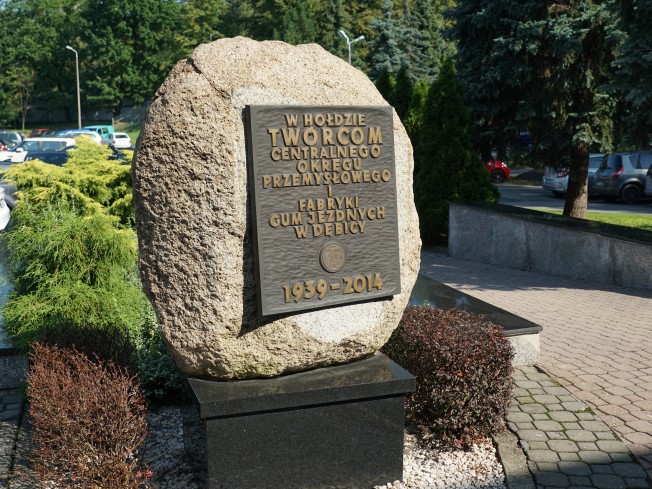THE ROUTE:
● TC Stomil Dębica Plant – Entry Gate
● TC Stomil Dębica Plant – Yard
● Water Tower
● Regional Museum in Dębica
Distance between the sites
Total length of the Route: 6.7 km
On foot – total walking time: 83 min.
By bike – total riding time: 25 min.
The origins of the plant in Dębica go back to 1937, when the decision was made to build there a branch of the Stomil S.A. company in Poznań, run by Jan Piotrowski, Ph.D. That locality was chosen because of the tax reliefs, strategically advantageous location of this part of the Region and the availability of cheap labour. Dębica as the prospective seat of the new plant was also supported by the military authorities, who envisaged manufacturing tyres for military vehicles there.
The production was launched on 30th March 1939, which was possible due to the great commitment of the builders. It must be emphasized that the entire plant, of a total area of 9,500 m2, was built without using any heavy construction equipment. First, in the spring of 1938, the prospective development area was deforested and the earthworks began. The steel structure of the plant hall (232m long and 32m wide) was up as early as 30th June.
The architecture of the plant buildings was unique in comparison with other CIR development projects. Decorative and functional elements were combined here in an unusual way, with emphasis on contrasting details, involving brick and light-coloured plaster – thus, the recesses were accentuated. Together with rows of pilasters between the windows, they constituted a uniformed visually attractive façade. As regards the architectural leitmotif to be found in the plant facilities, it was the repeatability of the form, so typical of the designer and architect Marian Andrzejewski. Multiplied were the sections of the shed roof at the main production hall, the leaded windows of the boiler house, and the metal rods of the entrance gate, whose characteristic arrangement, at an angle, was a hint at the treads of the tyres manufactured in the plant. This gate, still extant, is the first item on the Route.
Another place related to the Central Industrial Region period is the yard in front of the TC Stomil plant, which is currently used by the plant workers as a parking area (in 1-go Maja street). Here, we can take a look at the plant buildings. At the square is a long building, which today constitutes a pedestrian gate leading to the premises. This building goes back to the first years of the plant.
What is worth mentioning are the interiors of the former plant (today modernized, and not open to tourists). An interesting element which influenced the interiors was the characteristic saw-shaped roofs, found both over the production and office buildings. Due to its shape, more light could get inside, which facilitated the appropriate work-conducive conditions in the rooms and halls.
Attention was paid to the appropriate conditions for the workers. They could use a canteen, shower blocks, as well as functional cloakrooms – neat and modern. There were plans for a workers’ housing estate and a park.
A particularly interesting structure is the water tower (its capacity: 1080 m3) that was built together with the plant in the summer of 1938. The tower is another site on our Route – it is still extant, although no longer used. It may be seen at 18 Matejki street, standing out among the low-rise blocks of flats. Its interior is not available for tourists.
From the water tower, we go along Krakowska and Żeromskiego streets, and then Kościuszki street, to reach the Regional Museum in Dębica (at 4 Ratuszowa street), opened in 2003. Its permanent exhibitions are focused on the history of the town and the surrounding areas, from prehistoric times until the end of World War II. Some of the exhibits are related to the Central Industrial Region and the consequent construction projects implemented both in Dębica and its vicinity. In the museum cinema room, multimedia materials are shown on many topics related to the CIR project.
After visiting the museum, we take Kościuszki street to get to the intersection with Głowackiego street, and then go on, for about 350 metres, to reach the bus station in Sybiraków square.





